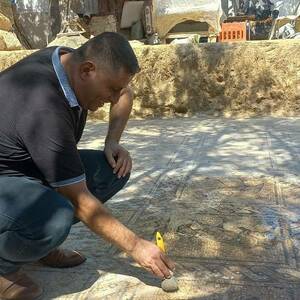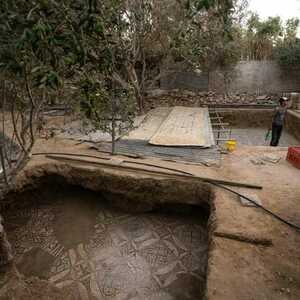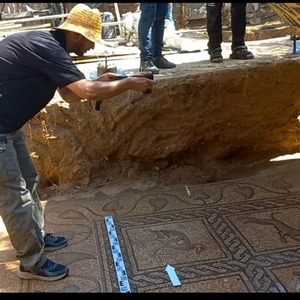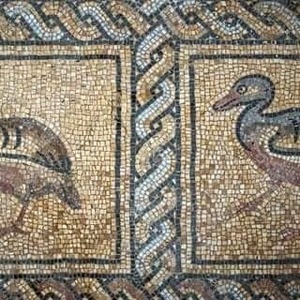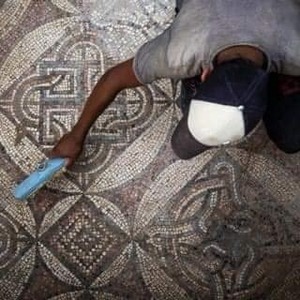'Sepectacular' discovery of vast 5th-7th century mosaics in Gaza
The mosaics could have adorned the floor of a church or a private villa, according to René Elter, an archeologist from the French Biblical and Archaeological School of Jerusalem who has worked in Gaza.
Mosaics dating from the 5th to 7th centuries were unearthed by farmers in Gaza refugee camp in an orchard in the central Gaza Strip. They were discovered by Palestinian farmer Salman al-Nabahin and his son as they were planting an olive tree on their land last spring.
Although parts of the mosaic had been damaged by the roots of old olive trees, these brightly colored mosaics featuring 17 iconographies of beasts and birds are “in perfect state of conservation”, declared Elter, adding that it is "the most beautiful mosaic floor" found in Palestine.
"This is a first: on the one hand, this mosaic is very beautiful for the finesse of the work and on the other hand, it is exceptional because it is in a state of conservation that we do not have elsewhere in Gaza. added Elter, whose team examined the discovery.
"It is a work of excellent quality, they used materials that were certainly relatively expensive," said the French archeologist, noting the "shimmering colors" of the work, which he estimates dates from the 5th to the 7th century.
But Elter expressed concern that the discovery is in “immediate danger” because its closeness to the Israeli fence. "It is imperative to quickly organize an emergency rescue intervention," he says.
In January, construction workers discovered the remains of a 2,000-year-old Roman necropolis in Jabalia, in the north of the Palestinian enclave with a population of 2.3 million.
Originally published by at tantur.org on September 20, 2022.
Latest Research
- Finding fusion: an engineer and neurosurgeon unite to improve spinal surgeryIt is the summer of 2023, and Dr. Stephen Smith sits face-to-face with a model skeleton in the Engineering North building on the University of Notre Dame campus. Smith is a neurosurgeon at Beacon Health System’s Memorial Hospital in downtown South Bend, Indiana, about a mile southwest of the…
- Notre Dame Law School Global Human Rights Clinic announces winners of 2025 Global Human Rights Practice Writing CompetitionIn Spring 2025, the Global Human Rights Clinic launched the inaugural Global Human Rights Practice Writing Competition to recognize outstanding student scholarship on the practice of international human rights law. Open to J.D., LL.M., and J.S.D. students, the competition invited submissions…
- In Memoriam: Sriram SomanchiSomanchi was a widely respected teacher and scholar whose research broke new ground in the academic landscape by drawing on social science and statistical machine learning to develop and deploy methods that bridge these related but distinct disciplines.
- Notre Dame business professor ranked No. 1 in published researchDean Shepherd, Ray and Milann Siegfried Professor of Entrepreneurship at the University of Notre Dame’s Mendoza College of Business,…
- Airborne disease detection made easier with new, low-cost deviceAirborne hazardous chemicals can be dilute, mobile, and hard to trap. Yet accurately measuring these chemicals is critical in protecting human health and the environment. Now, a new, small, low-cost device, nicknamed ABLE, could make the collection and detection of airborne hazards much easier and faster. The device, just four by eight inches across, was devised by Jingcheng Ma, assistant professor of mechanical engineering at the University of Notre Dame, and researchers at the University of Chicago. The results of their work were published in Nature Chemical Engineering.
- University of Notre Dame and Dublin City University set to collaborate on new Precision Biomedical Technologies…








